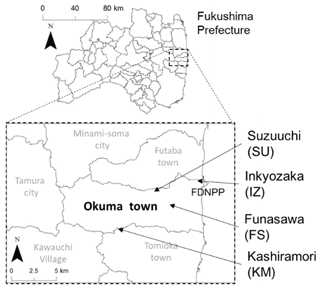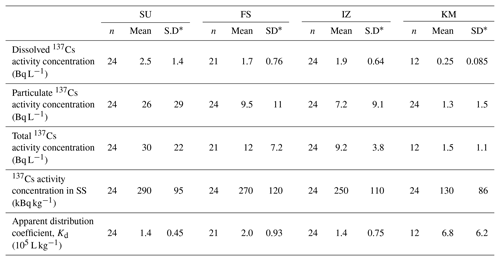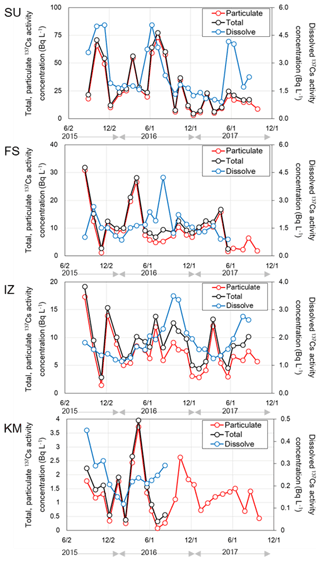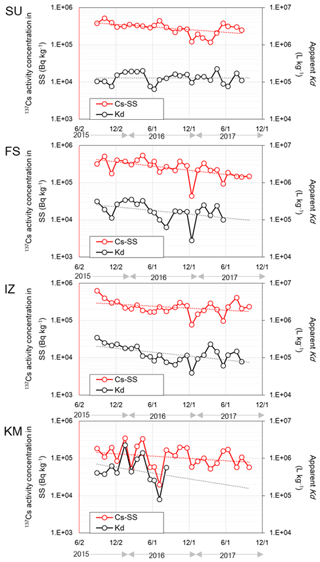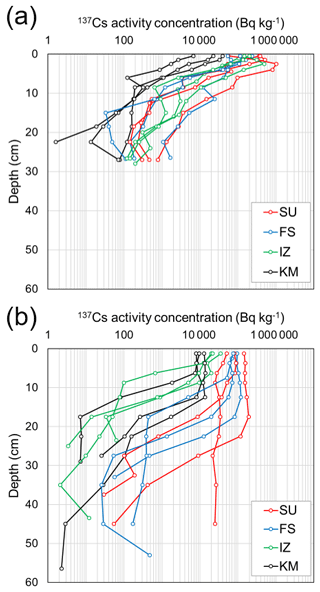the Creative Commons Attribution 4.0 License.
the Creative Commons Attribution 4.0 License.
Temporal trends of 137Cs activity concentration in pond waters in the vicinity of Fukushima Dai-ichi nuclear power plant
Yoshifumi Wakiyama
Alexei Konoplev
Toshihiro Wada
Tsugiko Takase
Yasunori Igarashi
Kenji Nanba
Ian Byrnes
Closed and semi-closed water bodies, such as lakes and ponds, are important water resources in Fukushima area and they are the most sensitive environments to radioactive contamination after the Fukushima Dai-ichi nuclear power plant accident. Wakiyama et al. (2017) investigated 137Cs activity in water and bottom sediment in four ponds; Suzuuchi (SU), Funasawa (FS), Inkyozaka (IZ), and Kashiramori (KM), within 10 km zone from the FDNPP during 2015–2016. This study follows up their observation to address longer time trends of 137Cs activity concentration in pond waters and to show speciation of 137Cs in soil and bottom sediment. Mean total 137Cs activity concentration in water ranged from 2.5 to 29 Bq L−1. There was not found steady trend in the activity concentration of total and particulate 137Cs for four ponds. The concentration of dissolved 137Cs was usually low in winter during the entire observation period in all four ponds. A tendency to a decrease in the 137Cs activity concentration in suspended sediments was found for four ponds and the decreasing rate constants, including radiological decay, on SU, FS, IZ and KM were 0.33, 0.53, 0.29 and 0.25 yr−1, respectively. The results of sequential extractions of soil and bottom sediment samples showed higher proportion of bioavailable 137Cs, i.e., exchangeable and organic bound 137Cs, in bottom sediment than in the soil.
- Article
(618 KB) - Full-text XML
- BibTeX
- EndNote
Closed and semi-closed water bodies, such as lakes and ponds, are the most sensitive environments to radionuclide contamination. More than 3700 individual irrigation ponds of different sizes are located in Fukushima Prefecture, which are radiologically contaminated after the Fukushima Dai-ichi nuclear power plant (FDNPP) accident. The Tohoku Regional Agricultural Administration Office of the Ministry of Agriculture, Forestry and Fishery (MAFF) and the Fukushima Prefectural government (MAFF and Fukushima prefecture, 2015) investigated 2679 ponds in Fukushima Prefecture and reported their water and sediment contamination levels.
The long-term behaviour of radiocesium in a closed and semi-enclosed water system affected by the Chernobyl accident can serve as a basis for long-term prediction of changes in environmental radioactive contamination in Fukushima. For example, Putyrskaya et al. (2009) presented the results of more than ten years of observation on the behaviour of 137Cs in several lakes affected by the Chernobyl accident and elaborated a model calculation of temporal variations in the concentration of 137Cs activity concentration of the lake water. However, the meteorological and geographical conditions in these areas are different from those in the Fukushima area, and the applicability of these results requires verification (Konoplev et al., 2016).
Wakiyama et al. (2017) demonstrated radiological contaminations in four ponds in the vicinity of FDNPP based on one-year observation. Although they suggested seasonal variation of dissolved 137Cs activity concentration of water, long-term trends remained unclear due to short period of their observations. This study shows longer temporal trends of 137Cs activity concentration in pond waters, as a continuation of observations undertaken by Wakiyama et al. (2017). In addition, we evaluated contamination of bottom sediment and its speciation.
2.1 Study site
Selected irrigation ponds of Suzuuchi (SU), Funasawa (FS), Inkyozaka (IZ) and Kashiramori (KM) are located in the city of Okuma within a radius of 10 km from FDNPP (Fig. 1). The surface area of these ponds of SU, FS, IZ and KM was 4100, 10 700, 6500 and 8100 m2, respectively, and ambient dose equivalent rates measured on March 2014 around SU, FS, IZ and KM were 24, 6.0, 11 and 3.3 µSv h−1, respectively (Wakiyama et al., 2017). The average annual precipitation and the average annual air temperature in this region were 1493 mm and 12.3 ∘C, respectively, according to Namie weather station data from 1976 to 2015.
2.2 Sampling and analyses of pond water
We had collected 2 L of water samples from the four ponds approximately once a month since August 2015 to August 2017. Then, water samples were filtered using 0.45 µm-pore cellulose acetate membrane filter units in the laboratory. Suspended sediment (SS) concentrations in water (SSC, kg L−1) were quantified by dividing weight of SS by volume of filtered water. Suspended sediments and filtrates were measured with Ge detectors to quantify the 137Cs activity concentration in SS (CCs-SS, Bq kg−1) and dissolved 137Cs activity concentration (CCs-dis, Bq L−1), respectively. Measurements of 137Cs activity were done with standard electrode coaxial Ge detectors (CANBERRA GC4020, Canberra, USA) with relative efficiency of 42.6 % at the Institute of Environmental Radioactivity, Fukushima University. Measurements were taken for 90 000 s for 137Cs activity concentrations in SSs and 240 000 s for dissolved 137Cs activity concentrations to ensure minimal statistical errors, which were <5 % and <10 %, respectively.
Particulate 137Cs activity concentration in water (CCs-par, Bq L−1), total 137Cs activity concentration in water (CCs-tot, Bq L−1), and the apparent distribution coefficient (Kd, L kg−1), were calculated by following equations.
2.3 Sampling and analyses of soil and bottom sediment
Soil and bottom sediment samples were collected in June 2016. Soils at a depth of 30 cm using a liner core sampler DIK-110C (DAIKI, Japan) with a plastic cylinder insert 5 cm in diameter. In laboratory, surface soils, to the depths of 3–5 cm, were cut for every 1–2 cm, and then remained subsurface soils were cut by 3–5 cm. Each soil sample was dried at 50 ∘C for at least three days, then ground and homogenized in a mortar. Three cores of bottom sediment were obtained using 4 cm diameter polyvinyl core tubing in each pond. The bottom sediment cores were taken from a boat and the sampling depth ranged from 33 to 56 cm. Bottom sediments to the depth of 10 cm were cut for interval of 2.5–5 cm, and subsurface bottom sediments were cut by 5–10 cm.
Each bottom sediment sample was dried at 50 ∘C for at least three days, then ground and homogenized in a mortar. The homogenised samples of both soil and bottom sediments were packed into 100 mL containers and measured to determine its 137Cs activity concentration (Bq kg−1). The measurements were done with standard electrode coaxial Ge detectors (CANBERRA GC4020, Canberra, USA) with relative efficiency of 42.6 % at the Institute of Environmental Radioactivity, Fukushima University. Measurements were taken up to 85 600 s to ensure a minimal statistical error of <5 % for almost samples. Eight samples taken from the deep portion of the bottom sediment had low 137Cs activity concentrations, at a minimum of 1.83 Bq kg−1, and high relative error, at 12.8 % maximum.
The proportion of 137Cs in the exchangeable fraction, the organic fraction and the fraction strongly bound to the particles in the soil and bottom sediment were evaluated by a sequential extraction. Soil samples for quantifying the proportion were prepared by mixing up 0–1 and 1–2 cm of soil samples which are described in Sects. 2–3. The soil samples were passed through 2 mm-mesh sieves. Bottom sediment for quantifying the proportion were additionally taken by an Ekman-Berge sampler on June 2016, simultaneous to bottom the core sampling. The bottom samples were dried at 50 ∘C.
The exchangeable fraction of the soil and bottom sediment were extracted with 1 M CH3COONH4 and the extract was measured for 137Cs activity. Subsequently, organic matter was decomposed with mixture of 5 % of H2O2 solution and nitric acid. The extract was measured for 137Cs activity. The measurements were done with same Ge detectors for soil and bottom sediment samples. Measurements were taken up to 53 000 s to ensure a minimal statistical error of <5 %. Only for the organic-bound fraction of 137Cs in bottom sediment from IZ, relative error was 14.6 % because of low 137Cs activity.
3.1 137Cs activity concentrations in pond water
The observation results are presented in Table 1. Particulate 137Cs accounted for 73 %–88 % of total 137Cs, on average. The mean apparent Kd value ranged from 1.4×105 to 6.0×105 L kg−1. These values were higher than those observed in the Chernobyl area by at least one order of magnitude, as previous authors suggested (e.g., Tsukada and Ohse, 2016). These results show a stronger affinity of 137Cs for sediment particles in Fukushima.
Figure 2 shows temporal variations in total, particulate and dissolved 137Cs activity concentration in pond water. Both total and particulate 137Cs activity concentrations varied significantly throughout observation, and the temporal variations were similar. These similar variations were attributed to high proportions of particulate 137Cs activity concentration, as shown in Table 1. In contrast, the concentration of dissolved 137Cs was usually low in winter during the entire observation period in all ponds. These results confirm that the seasonal cycle exists on dissolved 137Cs in ponds, as it was previously found in the Chernobyl-affected area (e.g., Putyrskaya et al., 2009).
Decreasing trends of 137Cs activity concentration in SSs were found for all ponds (Fig. 3). The temporal trend of 137Cs activity concentration in SS was expressed by the following equation,
where t is the elapsed time since the accident (year), CCs-SS(t) is 137Cs activity concentration in SSs at time t (Bq kg−1), is initial 137Cs activity concentration in SSs at t=0 (Bq kg−1) and λ is rate constant including radiological decay (yr−1). The rate constant on SU, FS, IZ and KM were 0.33, 0.52, 0.29 and 0.25 yr−1, respectively. The corresponding periods of half-reduction for SU, FS, IZ and KM were 2.1, 1.3, 2.4 and 2.8 years, respectively. Since 137Cs activity concentration in SS was more variable than that dissolved 137Cs activity concentration, the temporal variation in apparent Kd seemed to coincide with changes in the 137Cs activity concentration in SS.
3.2 137Cs in soil and bottom sediment
The vertical distributions of 137Cs activity concentration in soil and bottom sediment are relatively similar for the all study sites (Fig. 4). As indicated by Wakiyama et al. (2017), the mean 137Cs inventory in the soil around SU, FS, IZ and KM were 6.8, 4.6, 2.9 and 0.42 MBq m−2, respectively. Similarly, mean 137Cs inventory in bottom sediment in SU, FS, IZ and KM were 13, 8.9, 1.6 and 1.1 MBq m−2, respectively. The 137Cs activity concentration both in the soils and bottom sediments decreased with depth.
The depth at which the soil contains 90 % of the inventory of 137Cs in the soil around the SU, FS, IZ and KM were 5, 7.6, 9.7 and 6.7 cm, respectively. The depth at which the soil contains 90 % of the inventory of 137Cs in bottom sediment on SU, FS, IZ and KM were 30, 17, 8.3 and 12.5 cm, respectively. Deeper penetration of 137Cs into bottom sediments than in the soil were found with the exception of IZ.
At least 95 % of 137Cs in soil was strongly bound to sediment particle in soil, while the 137Cs content in bottom sediment ranged from 42 % to 72 % (Fig. 5). The low proportions of 137Cs strongly bound with particle in bottom sediment, suggest that the bioavailability of 137Cs was increased in bottom sediments.
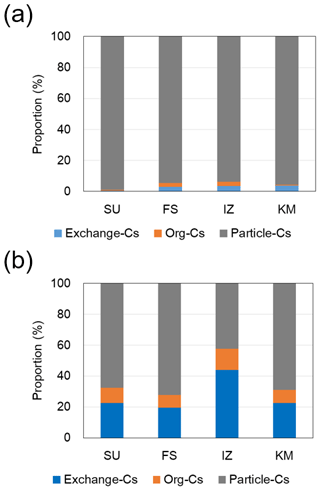
Figure 5Proportion of exchangeable, organic and particle bound fractions of 137Cs in soil of 0–2 cm depth (a) and bottom sediment by an Ekman–Berge sampler (b).
Putyrskaya et al. (2009) demonstrated that percentage of exchangeable 137Cs was 5.7 % in average in 2006, based on sequential extraction of bottom sediment taken in lakes affected during the Chernobyl accident. Although the depth and water flow regime of ponds, located near Chernobyl, differed from ours, a high proportion of 137Cs in the exchangeable and organic fractions in Fukushima study sites suggested that the bioavailability of 137Cs in Okuma town ponds is still high.
These mobilities may have led to the vertical migration of 137Cs and controlled the fluctuation in dissolved 137Cs activity concentration. The effect of biological activities on 137Cs behaviour should be high in the spotlight.
We investigated the behaviour of 137Cs in four small ponds around Fukushima Dai-ichi nuclear power plant as a following-up of observation by Wakiyama et al. (2017). Continuous monitoring of 137Cs activity concentration in water confirmed the presence of a seasonal cycle of dissolved 137Cs activity concentration and newly revealed tendencies to a decrease trends in 137Cs activity concentration in suspended sediment for all ponds.
In addition, the sequential extractions of sediment samples showed a higher proportion of 137Cs in the exchangeable and organic fractions in bottom sediments than in soils and this indicates an increase in the bioavailability of 137Cs in bottom sediment. The effect of biological activity should be tested to better understand 137Cs activity in ponds.
The data can be accessed by request to authors.
YW: Sampling, analyses and discussion as corresponding author. AK: Sampling, sample treatment and discussion. TW: Sampling, and discussion. TT: Sample analyses, and discussion. YI: Sampling, analyses, and discussion. KN: Sampling, discussion, and facilitating observation. IB: Sampling, sample treatment, and discussion.
The authors declare that they have no conflict of interest.
This article is part of the special issue “Land use and climate change impacts on erosion and sediment transport”” It is a result of the ICCE Symposium 2018 – Climate Change Impacts on Sediment Dynamics: Measurement, Modelling and Management, Moscow, Russia, 27–31 August 2018.
This study was supported by a grant-in-aid from the Kurita Water and Environment Foundation (No. 15B098 and 16K023). This study was partly supported by JSPS KAKENHI project 18H03389. The authors would like to thank Kenji Watanabe, Azusa Goto and Jun Obara in Institute of Environmental Radioactivity, Fukushima University for supporting sampling and measurements in this study.
This research has been supported by the Kurita Water and Environment Foundation (grant no. 15B098 and 16K023) and partly supported by JSPS KAKENHI (project 18H03389).
Konoplev, A., Golosov, V., Laptev, G., Nanba, K., Onda, Y., Takase, T., Wakiyama, Y., and Yoshimura, K.: Behavior of accidentally released radiocesium in soil-water environment: looking at Fukushima from a Chernobyl perspective, J. Environ. Radioact., 151, 568–578, https://doi.org/10.1016/j.jenvrad.2015.06.019, 2016.
MAFF and Fukushima prefecture: About actual situation of radionuclides in ponds etc: an overview of investigation results obtained by a demonstration project for countermeasures against expanding contamination in ponds etc., available at: http://www.maff.go.jp/j/kanbo/joho/saigai/pdf/tameike_tyousa26.pdf (last access: 8 December 2016), 2015.
Putyrskaya, V., Klemt, E., and Röllin, S.: Migration of 137Cs in tributaries, lake water and sediment of Lago Maggiore (Italy, Switzerland) – analysis and comparison with Lago di Lugano and other lakes, J. Environ. Radioact., 100, 35–48, 2009.
Tsukada, H. and Ohse, K.: Concentration of radiocaesium in rice and irrigation water, and soil management Practices in Oguni, Date, Fukushima, Integr. Environ. Assess. Manage., 12, 659–661, 2016.
Wakiyama, Y., Konoplev, A., Wada, T., Takase, T., Byrnes, I., Carradine, M., and Nanba, K.: Behavior of 137Cs in ponds in the vicinity of the Fukushima Dai-ichi Nuclear Power Plant, J. Environ. Radioact., 178–179, 367–376, 2017.






